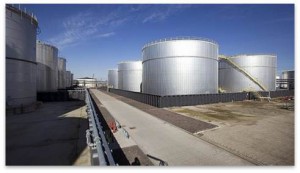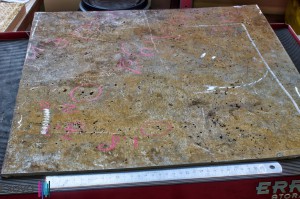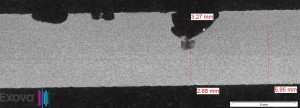Corrosion in storage tanks for biofuels

In the storage sector of biofuels, corrosion problems related to the “bio” components in diesel are increasingly being identified. The alleged cause is mainly the Fatty Acid Methyl Ester (FAME). The problem with the first generation of these fuels is that they contain more water (up to 30x more) than traditional fuels. Due to the stagnant product in the storage tank, the water present sinks out and the bacteria in it are fed by nutrients in the fuel (carbon source), resulting in microbial influenced corrosion (MIC). The speed of this type of corrosion can be up to 100 x higher than “normal” corrosion and perforate the tank bottom and wall in a relatively short time.
Different bacteria involved in corrosion live in symbiosis where they complement each other by creating perfect living conditions (aerobic and anaerobic). The slime-forming bacteria produce a biofilm under which the pH drops rapidly and the metal goes into solution. There are bacteria that use hydrogen that forms at the cathode to grow. As a result, the galvanic cell is further activated (cathodic depolarization). 
Reducing Bacteria are known to behave as diesel emulsifiers and trouble the oil. The Cladosporium Resinae flourishes in water in kerosene and can cause crack corrosion and the Bacillus Megaterium corrosion in Al-Cu aircraft tanks.
Biodesels are often stored in K3 tanks. These breathe freely from and to the outside air. FAME has the property of being hygroscopic, of low water content and not completely stable. As a result, the phenomenon occurs that moisture from the outside air enters the product and sinks below the product at a later stage. In this way even more water enters than it was already in it. The methyl esters in the FAME tend to turn into a (more) stable “acidic” compound. The aqueous solution under the product acidifies and the underlying tank bottom (and heating coils) sacrifice themselves in the resulting corrosion mechanism.
The EEMUA 159 does not specify a specific product group for biodiesels, but classifies fatty acids in product group 2, which means that it can be indirectly concluded that the corrosion rate (CR) must be high because the proposed time-based inspection, out of service intervals is very short (5) year)
Service Programme
- Inspection of tank bottoms and heating coils (scan)
- Risk Based Inspection
- Microbial analysis and source of contamination
- Prevention of (microbial) corrosion as a result of a water test with salt, brackish, drinking or demi water
- Reduce risks of post-contamination
- Prevention (post) contamination during tank cleaning
- Choice of coating on carbon steel tanks
- Coatings for aluminum and stainless steel tanks
- Plastic linings

Corrosion Control Technology Alliance
Contact: Frans van der Kolk
T. +31 (0)653206225
kolk@corrosioncontrol.nl